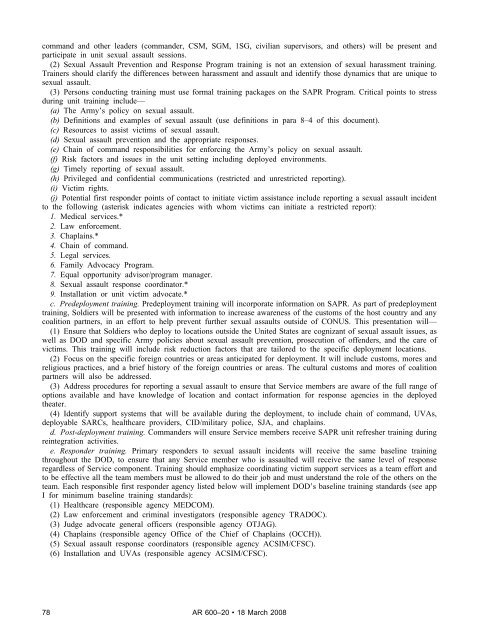AR 600-20, Army Command Policy - Army Publishing Directorate ...
AR 600-20, Army Command Policy - Army Publishing Directorate ...
AR 600-20, Army Command Policy - Army Publishing Directorate ...
You also want an ePaper? Increase the reach of your titles
YUMPU automatically turns print PDFs into web optimized ePapers that Google loves.
command and other leaders (commander, CSM, SGM, 1SG, civilian supervisors, and others) will be present and<br />
participate in unit sexual assault sessions.<br />
(2) Sexual Assault Prevention and Response Program training is not an extension of sexual harassment training.<br />
Trainers should clarify the differences between harassment and assault and identify those dynamics that are unique to<br />
sexual assault.<br />
(3) Persons conducting training must use formal training packages on the SAPR Program. Critical points to stress<br />
during unit training include—<br />
(a) The <strong>Army</strong>’s policy on sexual assault.<br />
(b) Definitions and examples of sexual assault (use definitions in para 8–4 of this document).<br />
(c) Resources to assist victims of sexual assault.<br />
(d) Sexual assault prevention and the appropriate responses.<br />
(e) Chain of command responsibilities for enforcing the <strong>Army</strong>’s policy on sexual assault.<br />
(f) Risk factors and issues in the unit setting including deployed environments.<br />
(g) Timely reporting of sexual assault.<br />
(h) Privileged and confidential communications (restricted and unrestricted reporting).<br />
(i) Victim rights.<br />
(j) Potential first responder points of contact to initiate victim assistance include reporting a sexual assault incident<br />
to the following (asterisk indicates agencies with whom victims can initiate a restricted report):<br />
1. Medical services.*<br />
2. Law enforcement.<br />
3. Chaplains.*<br />
4. Chain of command.<br />
5. Legal services.<br />
6. Family Advocacy Program.<br />
7. Equal opportunity advisor/program manager.<br />
8. Sexual assault response coordinator.*<br />
9. Installation or unit victim advocate.*<br />
c. Predeployment training. Predeployment training will incorporate information on SAPR. As part of predeployment<br />
training, Soldiers will be presented with information to increase awareness of the customs of the host country and any<br />
coalition partners, in an effort to help prevent further sexual assaults outside of CONUS. This presentation will—<br />
(1) Ensure that Soldiers who deploy to locations outside the United States are cognizant of sexual assault issues, as<br />
well as DOD and specific <strong>Army</strong> policies about sexual assault prevention, prosecution of offenders, and the care of<br />
victims. This training will include risk reduction factors that are tailored to the specific deployment locations.<br />
(2) Focus on the specific foreign countries or areas anticipated for deployment. It will include customs, mores and<br />
religious practices, and a brief history of the foreign countries or areas. The cultural customs and mores of coalition<br />
partners will also be addressed.<br />
(3) Address procedures for reporting a sexual assault to ensure that Service members are aware of the full range of<br />
options available and have knowledge of location and contact information for response agencies in the deployed<br />
theater.<br />
(4) Identify support systems that will be available during the deployment, to include chain of command, UVAs,<br />
deployable S<strong>AR</strong>Cs, healthcare providers, CID/military police, SJA, and chaplains.<br />
d. Post-deployment training. <strong>Command</strong>ers will ensure Service members receive SAPR unit refresher training during<br />
reintegration activities.<br />
e. Responder training. Primary responders to sexual assault incidents will receive the same baseline training<br />
throughout the DOD, to ensure that any Service member who is assaulted will receive the same level of response<br />
regardless of Service component. Training should emphasize coordinating victim support services as a team effort and<br />
to be effective all the team members must be allowed to do their job and must understand the role of the others on the<br />
team. Each responsible first responder agency listed below will implement DOD’s baseline training standards (see app<br />
I for minimum baseline training standards):<br />
(1) Healthcare (responsible agency MEDCOM).<br />
(2) Law enforcement and criminal investigators (responsible agency TRADOC).<br />
(3) Judge advocate general officers (responsible agency OTJAG).<br />
(4) Chaplains (responsible agency Office of the Chief of Chaplains (OCCH)).<br />
(5) Sexual assault response coordinators (responsible agency ACSIM/CFSC).<br />
(6) Installation and UVAs (responsible agency ACSIM/CFSC).<br />
78 <strong>AR</strong> <strong>600</strong>–<strong>20</strong> 18 March <strong>20</strong>08
















